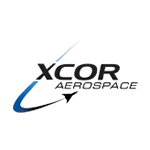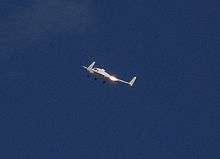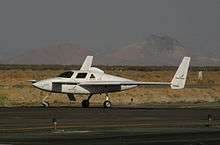XCOR Aerospace
 | |
| Private | |
| Industry | Aerospace and space tourism |
| Founded | September 1999 |
| Headquarters | Mojave Air and Space Port, Mojave, California[1] |
Key people | John H. Gibson (CEO) |
| Products | suborbital spaceflight |
| Revenue | n/a |
Number of employees | 40[1] |
| Website | www.xcor.com |
XCOR Aerospace is an American private spaceflight and rocket engine development company based at the Mojave Air and Space Port in Mojave, California, Midland International Air and Spaceport in Midland, Texas[2] and the Amsterdam area, the Netherlands.[3] XCOR was formed by former members of the Rotary Rocket rocket engine development team in September, 1999.
XCOR is headed by John "Jay" Gibson who is CEO.[4]
XCOR Aerospace is the parent operation and is concerned with engineering and building spaceships. There are two main subdivisions within it; XCOR Space Expeditions provides marketing and sales, and XCOR Science conducts scientific and educational payload flights.
History
The company was founded in Mojave, California in 1999[5] by Jeff Greason, Dan DeLong, Aleta Jackson and Doug Jones[1] who had previously worked at the Rotary Rocket company.[6]
In 2001, XCOR designed and built EZ-Rocket, the first privately built and flown rocket-powered airplane.[7] EX-Rocket made its maiden flight in July 2001.
XCOR moved its development and manufacturing operations to Midland, Texas from July 2012 to 2015.[5] The company uses the Mojave Air and Space port primarily to conduct test flights.[8]
In 2015, XCOR attracted investment from Chinese venture firm Haiyin Capital, valuing the company at $140 million.[9]
In mid-2015, John "Jay" Gibson succeeded Jeff Greason—CEO from 1997-2015—as CEO.[4][6][10] Later that year three of the co-founders, Jeff Greason, Dan DeLong and Aleta Jackson, left the company to found Agile Aero, an aerospace company focused on rapid development and prototyping of aerodynamic spacecraft.[11]
In May 2016, the company halted development of the Lynx spaceplane and pivoted company focus toward development its LOX/LH2 engine technology, particularly on a funded project for United Launch Alliance. The company laid off more than 20 people of the 50–60 persons onboard prior to May.[12]
By the end of June 2017, CEO Gibson was reported to have left the company, and the company was reported to have laid off all remaining employees.[13][14]
Projects



Lynx rocketplane
The Lynx was planned to be capable of carrying a pilot and a passenger or payload on sub-orbital spaceflights over 100 kilometres (62 mi). Between 20 and 50 test flights of Lynx were planned, along with numerous static engine firings on the ground. A full step-by-step set of taxi tests, runway hops and full-up flights were planned to get the vehicle to a state of operational readiness. Lynx was envisaged to be roughly the size of a small private airplane. It would be capable of flying several times a day making use of reusable, non-toxic engines to help keep the space plane's operating costs low.[15] The Lynx superseded a previous design, the Xerus spaceplane.[16] The Lynx was initially announced in March 2008, with plans for an operational vehicle within two years.[15] That date slipped, first to 2012,[17] then to 2015[18] and in January 2016 the company declined to give a projected date for the first test flight.[19] The Mark II was projected fly twelve to eighteen months after the first test flight depending on how fast the prototype moved through the test program.[15][18]
As of 2012, XCOR had presold 175 Lynx flights at US$95,000 each.[1]
On 27 May 2016, XCOR laid off a significant portion of its workforce and placed the development of the Lynx Spacecraft on indefinite hold to focus on development of a rocket engine.[20]
Thermoplastic polymer development
XCOR has developed Nonburnite, a cryo-compatible, inherently non-combustible composite material based on a thermoplastic fluoropolymer resin. Low coefficient of thermal expansion and inherent resistance to microcracking make it well suited to cryogenic tank use and also part of vehicle structure.[21]
XCOR/ULA liquid-hydrogen, upper-stage engine development project
In March 2011, United Launch Alliance (ULA) announced they had entered into a joint-development contract with XCOR for a flight-ready, 25,000 to 30,000 pounds-force (110–130 kN) cryogenic LH2/LOX upper-stage rocket engine. Partially as a result of positive results achieved from an earlier (2010) effort to develop a new aluminium alloy engine nozzle using innovative manufacturing techniques, ULA believes the new engine technology will save several hundred pounds of weight from the large engine and will "lead to significantly lower-cost and more-capable commercial and US government space flights."[22]
The "multi-year project’s main objective [was] to produce a flight-ready LOX/LH2 upper-stage engine in the 25,000 to 30,000 pounds-force (110 to 130 kN)-thrust class that costs significantly less to produce and is easier to operate and integrate than competing engine technologies" [23]
2011 demonstration test firings of an aluminum nozzle on XCOR’s Lynx 5K18 LOX/kerosene engine demonstrated "the ability of the aluminum nozzle to withstand the high temperatures of rocket-engine exhaust over numerous tests, with no discernable degradation of the material properties of the alloys. The tests validated the design, materials and manufacturing processes used in the nozzle, and laid a foundation for scaling the design to EELV-sized engines."[24]
As of 2011, the length of the development program was stated to depend on "the level of investment as milestones are met in the build-a-little, test-a-little approach favored by XCOR." If investment is minimized, flight engines would not be available for five to ten years.[23]
A subscale 2,500 pounds-force (11 kN)-thrust LH2/LOX engine was developed by 2013, named the XR-5H25, in order to support the XCOR/ULA engine development program. The first hot fire test of the prototype engine was in November 2013, the test was deemed successful.[25] It was also the first demonstrated use of a piston-pump-fed LH2 rocket engine, a new method to design "liquid hydrogen rocket engines that fundamentally breaks current cost, reliability and operational models."[25]
In April 2015, ULA announced that the XCOR/ULA joint-development rocket engine is one of the candidate engines for a new ULA upper stage rocket to be fielded no earlier than 2023. The Advanced Cryogenic Evolved Stage (ACES) is a long-life-on-orbit, high-performance, upper stage that, after consideration/competition by ULA, will use one of three engines to go into production with. The other engines under consideration are the 110-kilonewton (25,000 lbf)-Aerojet Rocketdyne RL-10 and the 670-kilonewton (150,000 lbf)-Blue Origin BE-3. ACES will be a second stage for the Vulcan launch vehicle after 2023, in lieu of the Centaur upper stage that is projected to fly on Vulcan as early as 2019.[26]
Historical projects
Completed projects have included:
- EZ-Rocket, a Rutan Long-EZ homebuilt aircraft fitted with two XR-4A3 400 pounds-force (1.8 kN) thrust rocket engines replacing the normal propeller engine.[27] EZ-Rocket has been flown at numerous airshows including the 2005 Oshkosh Airshow.[28] EZ-Rocket was "the first rocket-powered aircraft built and flown by a non-governmental entity."[1] On 3 December 2005, XCOR Aerospace flew its EZ-Rocket from Mojave, California to California City, California, both in Kern County. Test pilot Dick Rutan made the flight, which lasted about 9 minutes and carried US mail from the post office in Mojave to addresses in California City. This was the first time that a manned, rocket-powered aircraft was used to carry U.S. Mail.
- Rocket Racer - The EZ-Rocket program led to a second rocketplane design for the Rocket Racing League. It was built on a Velocity SE airframe and later became known as the Mark-I X-Racer. It was powered by an XCOR regeneratively cooled and pump-fed XR-4K14 rocket engine.[29] This rocket-powered aircraft flew several demonstration flights at the 2008 EAA AirVenture Oshkosh air show.[30] The total thrust for the single-engine Mark-I X-Racer has been variously reported as 1,500 lbf (6,700 N)[29] to 1,800 lbf (8,000 N),[31] approximately twice that of the EZ-Rocket initial prototype. The engine uses pressure-fed LOX and pump-fed kerosene, a combination that allows the fuel to be stored in the airplane's wing tanks while avoiding potential complications with pumping liquid oxygen.[32] After flight testing of the X-Racer was completed in 2008, XCOR completed seven rocketplane flights in one day.[1]
- Tea cart engine, a 15 lbf (67 N) thrust rocket motor burning nitrous oxide and ethane, mounted on a small industrial cart. The tea cart engine has repeatedly been fired indoors at conferences and demonstrations and had accumulated over 1,837 firings and 9,039 seconds of run time[33] by February 25, 2009.
- LOX/methane rocket engines in testing in 2005.[34]
- Early LOX/methane work led to a NASA contract, jointly with ATK, to develop a 7,500 lbf (33,000 N) engine for potential use as the CEV lunar return engine. On January 16, 2007 XCOR announced the successful test firing of a preliminary "workhorse" version of this engine.[35]
XCOR Space Expeditions
History
The Space Expedition Corporation (SXC) was founded by Harry van Hulten and Lt-Gen (ret.) Ben Droste in 2008. Initially operating under a wet-lease agreement with XCOR Aerospace, it was acquired by XCOR Aerospace in June 2014 and is now a fully owned subsidiary. Michiel Mol and Maarten Elshove joined SXC in 2010 and are thus considered founders. After the acquisition by XCOR Aerospace SXC was rebranded as XCOR Space Expeditions and integrated into the XCOR brand. XCOR Aerospace was organized as part of XCOR Corporate, but operated as the center of XCOR.[36]
Space Flights
XCOR Space Expeditions offers suborbital flights with the XCOR Lynx Mark I and Lynx Mark II Spaceships for the public. It will operate from Mojave, California, and Curaçao, where a spaceport is planned to be built.[37] There is no official date set for the start of operation.
XCOR Space Expeditions also offers medical check ups, training missions with space simulators and G-Force Fighter Jet flights for ticketholders, among other preoperational missions and events.[38]
Strategic partnerships have been created with global companies such as Philips, KLM, Heineken, Unilever and Luminox, among others.[39]
XCOR Science
XCOR Science will offer payload flights for educational institutions and science to conduct experiments in space.[40]
The Lynx Mark I and Mark II allow a maximum payload of 140 kg to be transported into space besides the pilot. Payloads are separated into two parts, whereas Payload A with a maximum capacity of 20 kg is situated in a vessel behind the pilot seat. Payload B with a mass up to 120 kg takes the space of the second seat.[41]
It is planned in the future to develop the Lynx Mark III which will have the same capabilities as the Lynx Mark II and will fly up to 100 km above ground. In addition to the payloads of the Lynx Mark I and II, the Lynx Mark III will have an external dorsal mounted pod which will hold up an extra 650 kg.[41]
Payloads will only be available from the Mojave space station in California.[41]
See also
References
- 1 2 3 4 5 6 Petty, Kathleen (2012-07-07). "A look at XCOR". Midland Reporter-Telegram. Retrieved 2012-07-09.
- ↑ Pappalardo, Jeff (July 2008). "New Area 51: Mojave's Desert Outpost Holds Space Flight's Future". Popular Mechanics. Retrieved 2008-07-24.
- ↑ "Contact". XCOR Aerospace. Retrieved March 24, 2016.
- 1 2 XCOR Aerospace Picks New CEO, accessed 2015-07-21
- 1 2 David, Leonard (2012-05-23). "Potential Colorado Spaceport Plan Gaining Steam". Space.com. Retrieved 2012-05-23.
- 1 2 "Our Team: Founders". Bios. XCOR Aerospace. Retrieved 2012-02-14.
Founders: Jeff Greason, President; Dan DeLong, Vice President and Chief Engineer; Doug Jones, Co-Founder and Chief Test Engineer; Aleta Jackson, Co-Founder and Manager
- ↑ Knapp, Alex (2014-06-18). "Bootstrapping To The Stars". Forbes. Retrieved 2014-06-19.
- ↑
- ↑ Alex Knapp (26 May 2015). "Chinese Venture Firm Haiyin Capital Is Investing In Space Company XCOR". Forbes. Forbes.
- ↑ XCOR Aerospace Company Overview, accessed 2009-02-19
- ↑ Jeff Foust (30 November 2015). "XCOR Co-Founders Establish New Company". SpaceNews.
- ↑ Foust, Jeff (2016-05-31). "XCOR lays off employees to focus on engine development". SpaceNews. Retrieved 2016-07-13.
- ↑ Midland Reporter-Telegram (5 July 2017). "Report: XCOR to lay off remaining employees". mrt.com. Retrieved 6 July 2017.
- ↑ Messier, Doug (5 July 2017). "XCOR Lays off Remaining Employees". parabolicarc.com. Retrieved 5 July 2017.
- 1 2 3 "XCOR Aerospace announces new suborbital vehicle "Lynx" to fly within two years". XCOR Aerospace. Archived from the original on May 9, 2008.
- ↑ Foust, Jeff (31 March 2008) One size may not fit all The Space Review, Retrieved 20 January 2015
- ↑ "Countdown has begin for SXC". Space Expedition Curacao. 2011-04-12. Retrieved 17 April 2011.
Early next year, we will make the first sub-orbital flight, after which the final development will speed up tremendously. According to our schedule, we will be ready for commercial take-off by the end of 2013
- 1 2 Norris, Guy (8 October 2014) XCOR Lynx Moves Into Final Assembly Aviation Week, Retrieved 20 January 2015
- ↑ "XCOR officials refrain from disclosing date for Lynx test flights". Midland Reporter-Telegram. January 17, 2016. Retrieved March 8, 2016.
- ↑ Jeff Foust (31 May 2016). "XCOR lays off employees to focus on engine development". SpaceNews.
- ↑ "A Perspective on XCOR’s Progress Towards Flying "Lynx"". RLV and Space Transport News. 2012-02-02. Retrieved 2012-02-13.
- ↑ "XCOR and ULA Demonstrate Revolutionary Rocket Engine Nozzle Technology — also sign contract for Liquid Hydrogen Engine Development". ULA. 2011-03-17. Retrieved 2011-03-23.
- 1 2 Morring, Frank, Jr. (2011-03-23). "ULA, XCOR to Develop Upper-Stage Engine". Aviation Week. Retrieved 2011-03-25.
United Launch Alliance (ULA) and XCOR Aerospace are planning a joint effort to develop a low-cost upper-stage engine in the same class as the venerable RL-10…"
- ↑ "XCOR and ULA Demonstrate Revolutionary Rocket Engine Nozzle Technology; Also Sign Contract for Liquid Hydrogen Engine Development". press release. XCOR Aerospace. 2011-03-22. Retrieved 2011-03-25.
- 1 2 Messier, Doug (2013-11-19). "XCOR Reaches Milestone in Liquid Hydrogen Engine Program". Parabolic Arc. Retrieved 2013-11-20.
- ↑ Gruss, Mike (2015-04-13). "ULA’s Vulcan Rocket To be Rolled out in Stages". SpaceNews. Retrieved 2015-04-19.
- ↑ "LOX-Alcohol Rocket Engine". www.xcor.com. XCOR Aerospace, Inc. Retrieved 2015-06-15.
- ↑ "XCOR To Fly EZ-Rocket At X Prize Cup Countdown", Space Daily, August 19, 2005, accessed February 19, 2009
- 1 2 Products Overview, XCOR Aerospace, undated, accessed 2010-12-27. "Twin 400 lb-thrust XR-4A3 engines aboard the EZ-Rocket" (with in-flight photograph) ... "Another engine that we have developed in parallel is the XR-4K14, ... a 1,500 lb thrust regeneratively cooled LOX and pump-fed kerosene system ... used as the Rocket Racer aircraft's main engine."
- ↑ XCOR X-Racer, by Nancy Atkinson, Universe Today, 2009-08-06, accessed 2010-04-26.
- ↑ X-Racers, Start Your Rockets! : The creators of the X prize offer a sensational vision of rocket-powered airplanes speeding through the sky. But can their new racing league steal a bit of Nascar's thunder?, Michael Belfiore, Popular Science (feature cover story), 2006-02-15, accessed 2010-09-02.
- ↑ Gatlin, Allison (2008-07-11). "XCOR performance tested". Antelope Valley Press. Archived from the original on July 15, 2009. Retrieved 2008-07-14.
- ↑ "XCOR Aerospace - 15 lb-thrust nitrous oxide / ethane rocket engine". XCOR Aerospace.
- ↑ "XCOR Aerospace Completes Successful Development of Methane Rocket Engine" (Press release). XCOR Aerospace. 2005-08-30. Retrieved 2012-12-03.
- ↑ "XCOR Aerospace Begins Test Firing of Methane Rocket Engine" (Press release). XCOR Aerospace. 2007-01-16. Retrieved 2012-12-03.
- ↑ XCOR, http://xcor.com/news/xcor-aerospace-acquires-space-expedition-corporation/?p=spaceexpeditions
- ↑ XCOR, http://spaceexpeditions.xcor.com/the-spaceflight/spaceports/
- ↑ XCOR, http://spaceexpeditions.xcor.com/the-spaceflight/space-programs/
- ↑ XCOR, http://xcor.com/about-us/partners/?p=spaceexpeditions
- ↑ XCOR, http://science.xcor.com/payloads/
- 1 2 3 XCOR, http://xcor.com/media/5886/2015002200001-xco-brochure-payloads-lr.pdf
External links
- XCOR Space Expeditions website
- XCOR Science website
- XCOR Aerospace website
- Rocket Racing League
- RocketShip Tours
- XCOR at CSF Members Meeting, Rick Searfoss, Chief Test Pilot (starts @1:22), Commercial Spaceflight Federation, 4 Sep 2013.